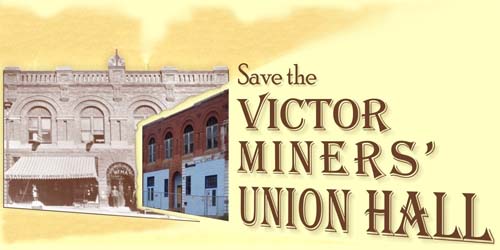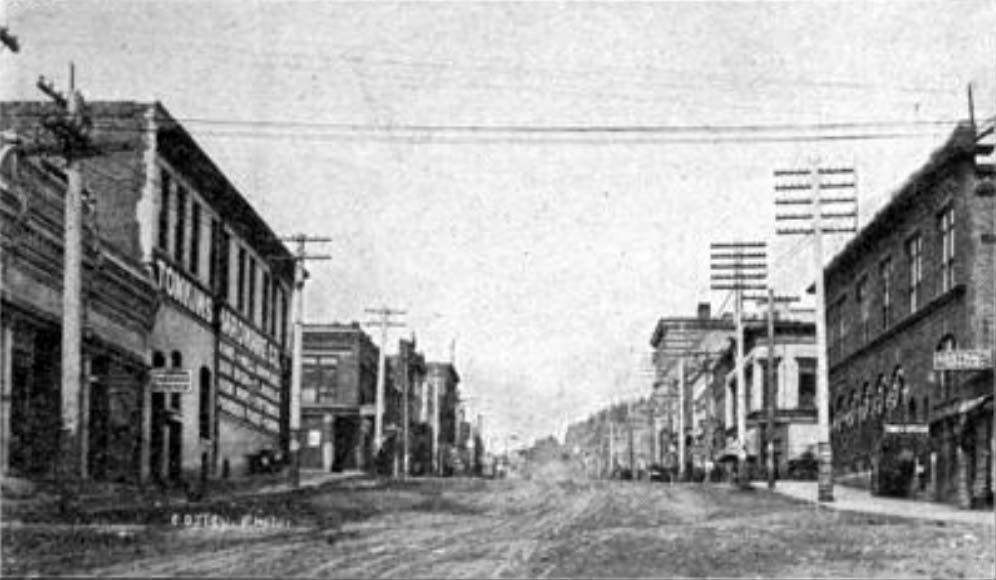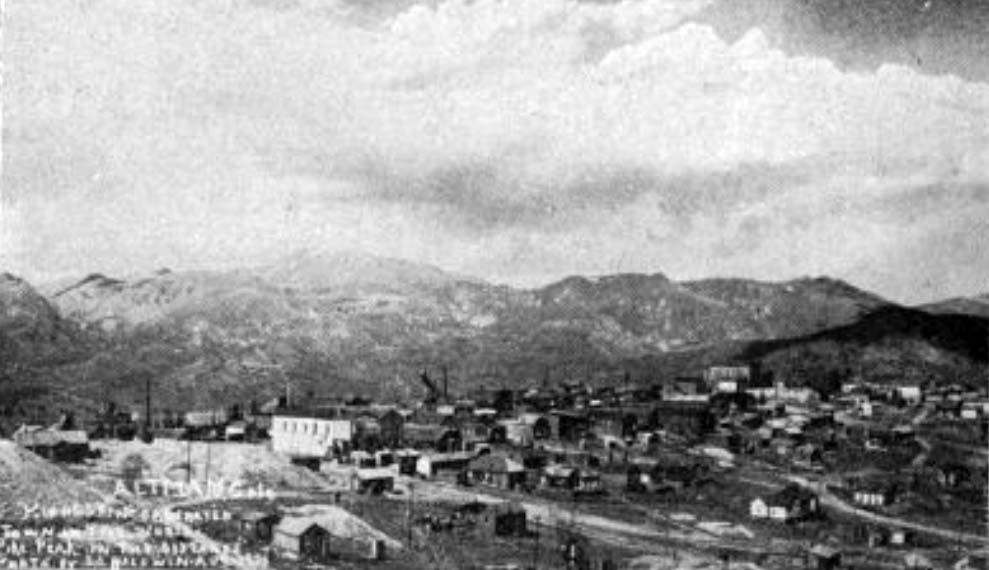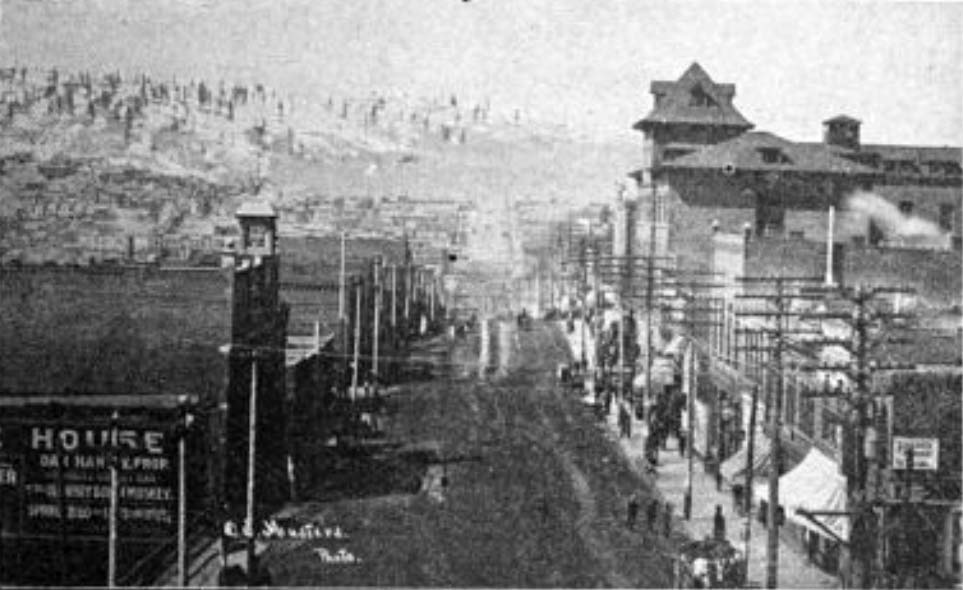 |
Victor
|

The
Cripple Creek
Strike:
a History of
Industrial Wars
in Colorado,
1903-4-5
By Emma Florence Langdon
pages 15 to 24
The Cripple Creek District
IN speeding toward the west, after many days of the same monotonous view of rolling prairie, stretching onward, ever onward, bounded only by the distant blue of the horizon, the weary traveler is startled by what at first appears to be an enormous white and blue cloud. The sight holds one spell bound with awe and admiration and it is many minutes before one can realize that the mighty mass looming up apparently from the prairie and piercing the sky is the first glimpse of that Titan sentinel among Titans, Pike's Peak, over seventy-five miles still to the westward.
The name is reminiscent of another time, and as the tourist of today is whirled across the continent, enjoying all the comforts of his home, he can hardly appreciate the hardships, the privations of those early Argonauts, whose slogan was "Pike's Peak or Bust" in the days of 1859. Words cannot adequately portray the vicissitudes and dangers of the time. The journey was made in what was commonly termed a prairie schooner. The dangers of such a trip were manifold, but the greatest source of anxiety arose from the hostile tribes of Indians. Along the line of the great transcontinental railroads, the bones of thousands lie bleaching, countless graves dot the prairie, graves of men and women who left their Eastern homes, who turned their backs on all they held dear in life and braved the terrors of an unknown country for gold.
Twenty years later, in 1879, the Mt. Pisgah excitement swept over the West, and a rush was made for the new Eldorado. This was an illusion, pure and simple, and the authors narrowly escaped well-deserved lynching. But the bitterness and irony of fate is evinced in both of these rushes. Almost in the shadow of Pike's Peak, the riches of Golconda awaited the prospector's pick;; while the fortune hunters who rushed to Mt. Pisgah walked over the Gold Coin, Portland, Independence, Vindicator, El Paso, Ajax, Last Dollar, Isabella and hundreds of other rich mineral deposits.
The Cripple Creek district, contributing as it does, the vast sum of $24,000,000 in gold annually to the world's wealth, has been for the last few years an object of great interest to the entire commercial world. The richness and magnitude of the treasure so cunningly hidden by the hand of nature in this store-house, has attracted the attention of both foreign and American capital, and the tourists who visit this wonderful gold camp are amazed at the extent of the great enterprises that he sees developing before him. Many discoveries have been made in the past ten years, of which I will speak very shortly, but first a word about the early prospectors. Mountains in the immediate vicinity of the mining belt were dotted, a few years ago, with little homes made preparatory for the wives and children who had been left behind and were coming to make their homes in the new camp. The number of these huts and cabins grew so rapidly that it soon became necessary to incorporate them into towns.
The prospector, with his old-fashioned windlass, slow method and hand drills, was rapidly displaced by the capitalist, monster steam and electrical appliances, steam hoist and steam drill. Railroad companies vied with each other in the display of wonderful and heretofore unheard of engineering feats in competition for the enormous receipts for ore transportation. The mines were surrounded with a net-work of steel rails, thrown over the mountain tops, and connecting the great gold producers with the smelters and mills in the valley below. The speculator and capitalist came to get that which the prospector had found, and from then until now every- inch of valuable ground, staked as a claim by the miner, has in some manner found its way into the hands of corporation capital.
As has been shown in the foregoing, Cripple Creek and Victor owe their present prosperous lives to the indomitable will and perseverance of a few early prospectors, who, notwithstanding the adverse opinions of experts, stuck doggedly to their claims. Gold was first discovered in 1889, but it was not until 1890-91 that its true worth was appreciated. The camp owes its prosperity to the financial panic of 1893, which brought thousands of unemployed to the district, owing to the fall in silver. About this time the fame of the district began to attract the attention of the experts, who, after thorough and exhaustive examinations, were almost a unit in their disapproval of it. Gold could not occur in this formation, they argued; pockets might be opened up, but as for continuous ore bodies, it was ridiculous. Never in the history of mining was the truth of the old axiom more sharply verified: "Gold is where you find it."

VICTOR AVENUE, Victor, Colorado.
From an unknown, obscure and doubtful mining camp—from a ranch where cattle browsed quietly day by day, where the cowboys lived and dreamed of fortunes to come, all unconscious of the millions beneath their feet, there has sprung, as if in a night, a mining district whose richness and extent has astonished the world. From a few huts and cabins have sprung cities—Victor and Cripple Creek—that compare favorably with any in the world for population. They are beautiful little cities of brick and stone buildings, fine homes, modern schools, morning and evening daily papers, churches of all denominations and hotels with all modern accommodations.
It is a common mistake made by people who have never lived in a mining town, to associate the name "mining camp" with a mushroom town, rough, rowdy men, who prefer outlawry to a good square meal. Imagine their surprise, when they visit the camp, to find instead, a beautiful city, with quiet, respectable and law-abiding citizens.
Cripple Creek is the county seat of Teller county, and ranks first in size of the ten incorporated towns of the district, having a population of from 12,000 to 15,000.

ALTMAN, Highest City in the World, on Bull Hill.
Victor is located in the extreme southern limit of the district, ranking next to Cripple Creek in size with a population of about 7,000. Goldfield, also has the honor of being a city of the second class in the district of ten incorporated towns. Goldfield has a population of nearly 2,000 and is only a nice walk from Victor.
Altman, upon the very crest of Bull Hill, enjoys the distinction of being the highest incorporated town in America, if not in the world. It is strictly a mining town and affords homes for the miners of that famous hill, who had rather live the year round at an altitude of nearly 11,000 feet above sea level than to be compelled to travel far from their place of employment. All of the other incorporated towns in the district are of more or less interest, but for lack of space I will pass them by.
At 1 o 'clock a. m. of April 25,1896, a woman of Cripple Creek, in a quarrel, overturned a gasoline stove and in that way started a conflagration which almost completely destroyed that city during its greatest boom. But soon the enterprising citizens of the flourishing little city were busy rebuilding.

BENNETT AVENUE, City of Cripple Creek.
Victor also had a fire which came near banishing it from the face of the earth, August 21, 1899. The fire will always be remembered and talked of by those who happened to be in the district at that time. The great Victor fire destroyed property to the value of a million dollars and rendered 3,000 people homeless at that time. The fire spread through the frame, pioneer buildings of the city as if it had been a heap of kindling wood. But there is no pluck like the pluck of the man who has upreared the cities and towns of the West. Calamity can not discourage him, for, checked in one direction, he will expend his energies in another. Victor was then, as now, the city of the mines, and as such she had reason for living. Her citizens brushed the smoke from their eyes, shoveled away the embers from their lots, and proceeded to build a bigger and more substantial city, the frame buildings which had been destroyed being replaced by stone and brick structures.